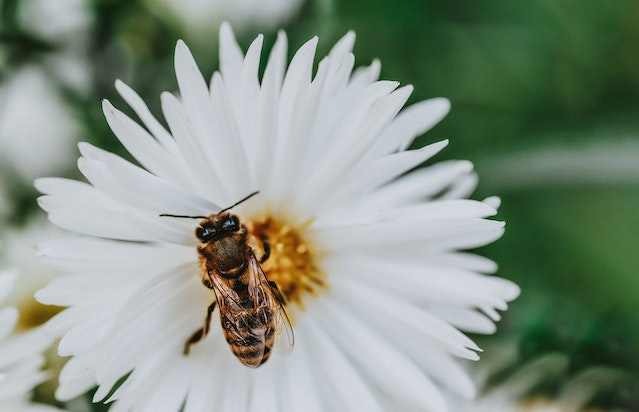
What animals and insects are pollinators? A large variety of animals and insects are pollinators. Many of us might think that flowers are only really pollinated by bees and butterflies when, in actual fact, there are a huge number of insects, reptiles, and mammals that are responsible for pollination.
What is pollination? A plant has male organs and female organs. The male organs are called the stamen and the female organs are called the stigma. The male organs make pollen, and it carries all of the genetic code for the plant. When the pollen is introduced into the stigma, it travels down a pollen tube until it comes into contact with an ovule, which it fertilizes. The ovule then becomes a seed and the stigma becomes a fruit.
There are some plants that can pollinate themselves, and there are some plants that are wind pollinated, but the vast majority of plants need a pollinator. 80% of the crops we use for food require a pollinator. A lot of grasses are wind pollinated, such as wheat, rice, and all the cereals. They don’t need to attract pollinators, so they don’t have any colorful flowers or nectar. They have very light and dry pollen that is easily blown by the wind. The disadvantage of wind pollination is there is no guarantee that the pollen will get to the stigma of another plant so they produce a large amount of pollen to increase the odds of the pollen landing on the stigma of another plant.
Self-pollination also has obvious advantages. There is no need for pollinators and the plants don’t have to waste energy on pretty colors and sweet nectar. They also don’t have to worry if the rest of their species die out. With self-pollinators, the plant grows so that the stamen are above the stigma and the pollen can just drop in. The disadvantage with self-pollinators is that they lose a lot of genetic diversity. When two organisms with different genes reproduce, they produce offspring with slightly different genes again and they give evolution a chance to work. When organisms self-pollinate, or reproduce with their siblings, there is no genetic diversity and evolution can’t improve the species. It is also very common for diseases to flourish.
So, what living creatures are pollinators? Let’s look at the obvious ones first. Bees and butterflies are huge pollinators. They both have hairs on their legs and abdomen. The nectar in the plant is deep inside so that the bees and butterflies have to squeeze past the stamen. When they do, the pollen gets caught on these hairs and they carry it to another plant, where it can reach the stamen.
Birds are pollinators. A lot of small birds, such as hummingbirds, feed on the nectar in plants and they carry pollen away on their feathers. Bats are also pollinators. Many flowers have evolved with bats in mind, and they flower at night. Figs, dates, mangoes, and peaches all flower only at night and are pollinated by bats. Bats are covered in fur and the fur gets covered in pollen.
Lizards are pollinators as well. On some islands, small lizards have evolved to drink the nectar of plants and they get the pollen caught in their scales, ready to be transferred to another plant. Lizards are not very common pollinators, and it tends to happen only on small islands where the plants don’t have a lot of other alternatives.
Beetles and cockroaches are pollinators. Beetles pollinate flowers that are white or green and that have a very fruity scent. They usually go for flowers that are more open because they have larger bodies, and it is easier for them. Most beetles can obviously fly, and they take the pollen with them.
Mosquitoes are very common pollinators. The female mosquitoes drink blood when they are trying to produce eggs, but male mosquitoes only feed on nectar and they pollinate when they do it. Some spiders are also pollinators.
Then we have larger mammals, such as rodents, mongooses, and others that feed on the nectar in flowers and get pollen stuck all over their faces.
And, the most surprising pollinator, at least to me, is the fly. Flies are almost as common as bees when it comes to pollination. In fact, we couldn’t have chocolate without the tiny flies that pollinate the cacao flowers. Flies also feed on the nectar and carry the pollen around. There are many plants that have evolved to give off a rotten meat smell to attract flies. If you have a flower in your garden that doesn’t smell too pleasant, then that is probably why. And this is what I learned today.
Photo by Julia Filirovska: https://www.pexels.com/photo/honey-bee-on-white-blooming-flower-4913766/
Sources
https://australian.museum/learn/species-identification/ask-an-expert/what-is-pollination/
https://www.fs.usda.gov/managing-land/wildflowers/pollinators/who-are-the-pollinators
https://www.buzzaboutbees.net/wind-pollination.html
https://seeds.ca/pollinator/bestpractices/wind_pollination.html
https://www.pollinator.org/pollinators
https://www.toppr.com/ask/en-jp/question/what-happens-when-a-pollen-grain-falls-on-a-stigma/
https://www.fws.gov/story/unsung-heroes-pollination
https://www.audubon.org/news/what-do-birds-and-bees-have-do-global-food-supply
https://www.fs.usda.gov/wildflowers/pollinators/animals/beetles.shtml
https://extension.psu.edu/feeding-the-flower-flies-how-to-attract-flies-to-your-garden
https://www.nps.gov/articles/chocolate-midge.htm

[…] are the most common pollinator but not by any means the only. Bees travel from their hive to find flowers. When they find one, they enter the flower looking for […]